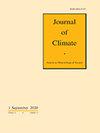A potential seasonal predictor for summer rainfall over eastern China: Spring Eurasian snowmelt
IF 4.8
2区 地球科学
Q1 METEOROLOGY & ATMOSPHERIC SCIENCES
引用次数: 0
Abstract
Abstract The hydrological effect of snow over Eurasia is important for regulating regional and global climate through affecting land-atmosphere energy exchange. Based on the observational and reanalysis datasets, this study investigates the effect of spring Eurasian snowmelt on the following summer rainfall over eastern China during the period of 1979–2018. The results show that a substantial meridional dipole pattern of summer rainfall anomalies over eastern China is closely associated with the preceding spring snowmelt anomalies over Eurasia, especially over the remote Siberia. Excessive snowmelt anomalies over Siberia in spring could result in a wetter local soil condition from spring until the following summer, thereby increasing latent heat fluxes and reducing local surface temperature, and vice versa. Then, the anomalous summer surface cooling over Siberia increases the meridional gradient of temperature between the Eurasian mid- latitudes and high-latitudes, which intensifies the Eurasian atmospheric baroclinicity and motivates the eddy- induced geopotential height responses along with the significant wave propagations spreading from the Eurasian high- latitudes to Lake Baikal. As a result, excessive spring snowmelt anomalies over Siberia tend to be accompanied with an anomalous anticyclone circulation to the east of Lake Baikal and an anomalous cyclonic circulation over southeastern China in the following summer. This could lead to a meridional dipole pattern of summer rainfall anomalies over eastern China, with deficient rainfall over northern China and slightly excessive rainfall over southern China. The present findings highlight the lagged effect of spring Eurasian snowmelt on summer climate over eastern China, with implications for the regional seasonal climate prediction.中国东部夏季降雨的潜在季节预测因子:春季欧亚融雪
摘要 欧亚大陆积雪的水文效应通过影响陆地-大气能量交换对区域和全球气候具有重要的调节作用。本研究基于观测和再分析数据集,研究了1979-2018年期间欧亚大陆春季融雪对中国东部夏季降水的影响。结果表明,中国东部夏季降雨异常的经向偶极子模式与欧亚大陆尤其是偏远的西伯利亚地区春季融雪异常密切相关。春季西伯利亚上空过多的融雪异常可能导致从春季到次年夏季当地土壤更加湿润,从而增加潜热通量,降低当地地表温度,反之亦然。然后,西伯利亚夏季异常的地表降温增加了欧亚大陆中纬度和高纬度之间的经向温度梯度,从而加剧了欧亚大陆大气的气压带性,并促使涡流引起的位势高度响应以及从欧亚大陆高纬度向贝加尔湖传播的显著波。因此,西伯利亚春季融雪过多的异常现象往往伴随着贝加尔湖以东的异常反气旋环流,以及随后夏季中国东南部的异常气旋环流。这可能导致中国东部夏季降雨异常的经向偶极模式,即中国北部降雨不足,而中国南部降雨略偏多。本研究结果凸显了春季欧亚融雪对中国东部夏季气候的滞后影响,对区域季节性气候预测具有重要意义。
本文章由计算机程序翻译,如有差异,请以英文原文为准。
求助全文
约1分钟内获得全文
求助全文
来源期刊

Journal of Climate
地学-气象与大气科学
CiteScore
9.30
自引率
14.30%
发文量
490
审稿时长
7.5 months
期刊介绍:
The Journal of Climate (JCLI) (ISSN: 0894-8755; eISSN: 1520-0442) publishes research that advances basic understanding of the dynamics and physics of the climate system on large spatial scales, including variability of the atmosphere, oceans, land surface, and cryosphere; past, present, and projected future changes in the climate system; and climate simulation and prediction.
 求助内容:
求助内容: 应助结果提醒方式:
应助结果提醒方式:


